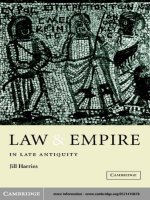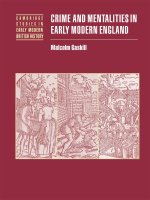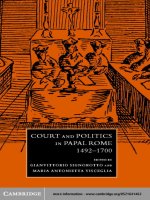0521802768 cambridge university press eating and drinking in roman britain jan 2007
Bạn đang xem bản rút gọn của tài liệu. Xem và tải ngay bản đầy đủ của tài liệu tại đây (2.39 MB, 300 trang )
This page intentionally left blank
EATING AND DRINKING IN
ROMAN BRITAIN
What were the eating and drinking habits of the inhabitants of
Britain during the Roman period? Drawing on evidence from a
large number of archaeological excavations, this fascinating new
study shows how varied these habits were in different regions and
amongst different communities and challenges the idea that there
was any one single way of being Roman or native. Integrating a
range of archaeological sources, including pottery, metalwork and
environmental evidence such as animal bone and seeds, this book
illuminates eating and drinking choices, providing invaluable insights into how those communities regarded their world. The book
contains sections on the nature of the different types of evidence
used and how they can be analysed. It will be a useful guide to all
archaeologists, and those who wish to learn about the strengths and
weaknesses of these materials and how best to use them.
is a professional archaeologist who, for the past ten
years, has run her own business providing post-excavation services
to the professional sector. She is also a director of Barbican Research
Associates, a company specialising in writing up backlog sites. Her
publications include The Roman Cemetery at Brougham, Cumbria
(2004) and (with J. Price) Roman Vessel Glass from Excavations at
Colchester 1971–1985 (1995).
HILARY COOL
EATING AND DRINKING IN
ROMAN BRITAIN
H. E. M. COOL
cambridge university press
Cambridge, New York, Melbourne, Madrid, Cape Town, Singapore, São Paulo
Cambridge University Press
The Edinburgh Building, Cambridge cb2 2ru, UK
Published in the United States of America by Cambridge University Press, New York
www.cambridge.org
Information on this title: www.cambridge.org/9780521802765
© Cambridge University Press 2006
This publication is in copyright. Subject to statutory exception and to the provision of
relevant collective licensing agreements, no reproduction of any part may take place
without the written permission of Cambridge University Press.
First published in print format 2006
isbn-13
isbn-10
978-0-511-25989-0 eBook (EBL)
0-511-25989-1 eBook (EBL)
isbn-13
isbn-10
978-0-521-80276-5 hardback
0-521-80276-8 hardback
isbn-13
isbn-10
978-0-521-00327-8paperback
0-521-00327-X paperback
Cambridge University Press has no responsibility for the persistence or accuracy of urls
for external or third-party internet websites referred to in this publication, and does not
guarantee that any content on such websites is, or will remain, accurate or appropriate.
173973
For Mike
who has patiently lived with me and the Romans for a very long time
Contents
395392
List of figures
List of tables
Preface
Acknowledgements
page ix
xi
xiii
xv
1 Ape´ritif
1
2 The food itself
8
3 The packaging
15
4 The human remains
21
5 Written evidence
30
6 Kitchen and dining basics: techniques and utensils
37
7 The store cupboard
56
8 Staples
69
9 Meat
80
10 Dairy products
11
93
Poultry and eggs
98
12 Fish and shellfish
104
13 Game
111
14 Greengrocery
119
15 Drink
129
16 The end of independence
152
17 A brand-new province
172
vii
viii
Contents
18 Coming of age
200
19 A different world
221
20 Digestif
243
Appendix: Data sources for tables
References
Index
246
253
275
353217
1.1
1.2
1.3
3.1
6.1
6.2
6.3
6.4
6.5
8.1
9.1
10.1
15.1
15.2
15.3
15.4
15.5
15.6
16.1
16.2
Figures
Map showing the principal sites mentioned in the text.
Detailed insets 2 and 3 for fig. 1.1.
Detailed inset 4 for fig. 1.1.
Amphora forms and their main contents.
Early third-century ‘north African’ casseroles and cooking
jars from York.
Tripod cooking bowls.
A selection of mortaria showing size ranges.
Boxplot showing the internal diameters of pottery mortaria
and stone mortars by date.
Metal vessels used in sacrifice and bathing, with altar.
Beehive and lava querns.
Cattle scapula from Castleford.
Military cheese presses and strainers from Longthorpe and
Holt.
Detail of the Simpelfeld sarcophagus showing the wine
service.
Metal vessels used for hand washing and the wine service.
Strainers used for infused drinks.
Pottery beakers with drinking mottos from Verulamium
and York.
Plot of the size of late second- to third-century pottery
beakers.
Comparison of the sizes of first-, third- and fourth-century
pottery beakers.
Pottery tablewares found in the King Harry Lane cemetery
showing the range of sizes.
Sizes of beakers used as accessory vessels at the King Harry
Lane cemetery compared to the size of motto beakers.
ix
page 4
5
6
17
40
41
42
44
48
72
90
96
137
139
145
148
149
150
156
165
x
List of Figures
17.1 Colchester. Sites in the vicinity and location of the
excavated sites within the fortress.
17.2 Leadenhall Court, London. Location of the site at
the north-west of the later forum basilica and main
excavation area.
17.3 Cremation Burial 25 at Stansted.
17.4 Burial 2 at Grange Road, Winchester.
18.1 The Uley temple complex.
18.2 The mithraeum at Carrawburgh.
19.1 Correspondence analysis plot showing the change of
glass-vessel assemblage compositions with time.
19.2 Correspondence analysis plot showing the changes in
pottery vessels available at York with time.
19.3 Correspondence analysis plot showing the changes in
pottery-vessel assemblages at Wroxeter with time.
19.4 Fourth-century silver spoons used in both pagan and
Christian worship.
173
181
196
197
212
214
225
229
233
241
353217
Tables
3.1 Amphorae as a proportion of total pottery assemblages.
page 18
3.2 Size and capacities of some of the commoner amphora
forms found on British sites.
19
4.1 Mean stature of adults in eight late Roman cemeteries.
25
4.2 Incidence of dental caries, enamel hypoplasia and cribra
orbitalia.
26
4.3 The incidence of DISH in sexed individuals over the age of
45 at Poundbury.
28
6.1 Incidence of sooting, burning and limescale on different
categories of pottery vessels.
38
6.2 A comparison of the functional categories in selected late
second- to third-century samian assemblages.
46
7.1 A comparison of dated amphora assemblages.
60
7.2 The presence/absence of amphora types in dated
assemblages.
61
7.3 The presence/absence of various spices in waterlogged
deposits.
65
9.1 A comparison of later first- to mid-second-century animal
bone assemblages.
81
9.2 The relationship between deadweight and meat yield.
81
11.1 A comparison of the recovery of different types of poultry at
selected urban sites.
99
11.2 A comparison of sheep/pig and poultry bone fragments
from Culver Street, Colchester and Fishbourne.
100
13.1 A comparison of sheep/pig and deer bones at selected sites.
112
14.1 The incidence of fruit remains in selected cesspits.
120
15.1 Wine sources at first-century forts.
133
15.2 Wine sources in London during the first century.
134
15.3 Incidence of metal vessels on different types of site.
140
16.1 Pottery forms from Braughing.
161
xi
xii
List of Tables
16.2 Pottery forms from Gorhambury.
16.3 Tableware forms in formal burials at the King Harry Lane
cemetery.
16.4 Incidence of cups in the graves at King Harry Lane.
16.5 Associations of the principal types of tablewares at the King
Harry Lane Cemetery.
17.1 Proportions of the principal domesticates at Colchester in
contexts dated to AD 49–60/1.
17.2 Amphorae-borne commodities in Colchester AD 44–60/1.
17.3 Pottery-vessel forms from Colchester AD 44–60/1.
17.4 Glass-vessel forms from Colchester AD 44–60/1.
17.5 Pottery and glass vessels associated with Phase 3 contexts at
Leadenhall Court, London.
17.6 Animal bone from the principal domesticates from selected
Fort I contexts at Castleford.
17.7 Pottery vessels from Fort I contexts at Castleford.
17.8 Glass vessels from Fort I and the Phase 1 vicus area at
Castleford.
17.9 Animal bone from the principal domesticates from Period
2 contexts at Claydon Pike and Period 1 contexts at Orton
Hall Farm.
17.10 Pottery vessels from Period 2 contexts at Claydon Pike and
Period 1 contexts at Orton Hall Farm.
17.11 The grave goods from the Bartlow burials.
18.1 Principal pottery and glass-vessel types from contexts of
Phases 2, 3 and 5 at Causeway Lane, Leicester.
18.2 Principal pottery and glass-vessel types from Claydon Pike
(Phase 3) and Parlington Hollins.
18.3 Animal bone from the principal domesticates from Period 3
contexts at Claydon Pike and Roman contexts at Parlington Hollins.
18.4 Animal bones from Phase 4 contexts at Uley.
18.5 The pyre good-meat-bone associations for burials
at Brougham.
19.1 Glass-vessel assemblages of various dates quantified
according to form.
19.2 The principal pottery vessel forms in use in Roman York.
19.3 Pottery from late Roman and sub-Roman contexts at the
Baths Basilica, Wroxeter.
161
162
163
167
174
175
176
178
182
186
188
188
190
192
194
203
204
205
213
218
224
228
233
Preface
I decided to write this book as it combined three of my great interests in
life – food, drink and Roman Britain. Whilst few people would be
surprised at the first two, a passion for the third would raise eyebrows
in many archaeological circles. For much of my professional life just as
real men didn’t eat quiche, so real archaeologists didn’t do Roman
Britain. For Classical archaeologists, the province of Britannia was a
distant excrescence, far from the ‘proper’ archaeology of the Mediterranean lands. Within British archaeology, it was seen as the preserve of
arcane specialisms pursuing their own agendas far from where the theoretical action was. Whilst theory has now come to Roman Britain, it is still
an uncomfortable place for many. Modern tastes wish to do away with
anything that recalls colonialism, whilst rising nationalisms prefer not to
engage with periods when Britain was self-evidently part of a wider world.
Prehistory is still a safer, more comfortable and purer world for archaeologists to play in.
This is a great pity as Roman Britain is a very strange place, much
stranger than the many popular books written about it would lead one to
think. It is fully worthy of being studied in its own right, but that has to
be done on its own terms. This involves knowing how to interpret all the
data relating to it. The problem with Roman Britain is that there are just
too many things. Too much pottery, too much metalwork, too many
animal bones. People tend to be overwhelmed by the sheer volume. They
deal with it by picking out the occasional morsel, and hoping the rest will
go away. This book is offered as a kind of hitchhiker’s guide to those who
would like to explore this material, but who lose the will to live when
faced with the reams of specialist reports that even a minor excavation can
generate. It shows, I hope, how these reports can be used to explore
different facets of the past. I have chosen to explore eating and drinking
xiii
xiv
Preface
because not only does it interest me but, as the celebrated gourmet and
bon viveur Brillat-Savarin said ‘Tell me what you eat, and I will tell you
what you are’. Where better to start exploring Roman Britain?
Bon appetit!
353217
Acknowledgements
A book like this depends on the work of the specialists who have sorted,
identified, analysed and published the multitude of items on which it
is based. Their names are mentioned in the footnotes, but I would
like to put on record my thanks here, and my apologies too if I have
misrepresented them.
Over the years I have benefited from discussions with many people.
Those who have kindly answered questions specifically to do with this
book include Richard Brewer, Peter Davenport, Brenda Dickinson, Jerry
Evans, Andrew (Bone) Jones, Ruth Leary, Scott Martin, Quita Mould,
Stephanie Ratka´i, Paul Sealey and Vivien Swan. Special thanks are due to
Ruth and Scott, who made the results of currently unpublished work
available to me; and to Bone for reading the sections pertaining to fish.
Jerry has been particularly generous with unpublished work and useful
discussion. I’m sure he won’t agree with what I’ve made of it all, but
I hope he’ll enjoy the result. Alex Smith and Oxford Archaeology kindly
allowed me to refer to the results of the Claydon Pike excavations in
advance of full publication and provided additional details.
Jaye Pont is thanked for her invaluable guidance in matters pertaining to illustration software, and I am grateful to the West Yorkshire
Archaeological Service (via Chris Philo) and the Winchester Excavation
Committee (via Professor Martin Biddle) for providing figs. 9.1 and 17.4.
I would like to thank Cambridge University Press for publishing the
book, and the two editors who have overseen it, Jessica Kuper and Simon
Whitmore. Simon is owed special thanks for his forbearance over its much
delayed appearance. I am most grateful also to Sarah Parker, Joanna Breeze
and Gwynneth Drabble for their work in preparing the book for publication.
Mike Baxter provided fig. 15.1 and read the final draft which was much
improved by his comments. He has also provided constant encouragement and support during the book’s prolonged gestation, and indeed for
much longer than that. So, as is only right, this book is for him.
xv
xvi
Acknowledgements
The final stages of preparing the manuscript have been enlivened by
listening to the Test Match Special commentary of the thrilling 2005
England – Australia Ashes series. It has been most distracting – many
thanks to the players of both teams and the commentators.
CHAPTER
1
Ape´ritif
384847
This is a book that takes that most common question ‘What shall we have
for dinner?’ and uses it to explore the communities that lived in Britain
during the first half of the first millennium AD (a period that will
hereafter be called Roman Britain as a convenient shorthand). Subjectmatter such as this has not always been thought very respectable. Certainly
it has not been considered central to the story of Roman Britain. Yet in
many ways there is no better way of understanding past societies. Eating
and drinking are frequently about much more than sustaining life by the
ingestion of sufficient calories. What you can and cannot eat, who you can
and cannot eat it with, tends not to be so much a matter of personal
choice, as the result of social conditioning. By studying the eating patterns
of a society, you enter areas far beyond the mere nutritional. Eating and
drinking rituals will quite frequently take you into the realms of religious
beliefs, class, gender relationships, and ethnicity. Or, as Brillat-Savarin
said more succinctly, ‘Tell me what you eat, and I will tell you what you
are’.1
The information that can be used for this study is entirely dependent
on archaeological exploration. The scanty ancient sources that have traditionally underpinned the study of Roman Britain are virtually silent on
the topic; and, when they do say anything relevant, can generally be
shown to be unreliable witnesses. Archaeology, by contrast, produces data
in almost embarrassing abundance. We have so much information that
the problem is how best to use it, not just to explore eating habits, but also
any other topic of interest. Most of these data are in the specialist
contributions analysing and cataloguing the things found during excavation. These lurk behind the structural narratives of excavation reports
like the submerged part of an iceberg, and are a seriously underused
1
Brillat-Savarin 1826, 4th aphorism.
1
2
Eating and Drinking in Roman Britain
resource. I do not consider it an overstatement to say that they are where
Roman Britain resides though, being a specialist myself, it might be
considered that I am prejudiced. The patterns seen in the artefact and
environmental reports often cut across preconceived notions of how life
was lived in Britain during the earlier first millennium AD. It is my aim to
bring this information to wider attention and, in doing so, demonstrate
how it can be used.
If the specialist reports are so important, why are they so underused?
The answer lies in the fact that this knowledge base developed as a service
industry providing excavators with the information they needed to understand the structural narrative. It was generally very highly focused towards
the provision of dating evidence because of the way Romano-British
studies developed. There is a long history of studying the province
stretching back to the antiquaries of the eighteenth century such as
Stukely and Horsley. For many years the preferred approach was to use
the archaeology as an illustration of the meagre historical record derived
from the ancient sources. The role of the army, and the changing military
dispositions, took centre stage. For this the overwhelming need was to be
able to date sites, and to identify the different periods when particular
forts were occupied. This led to a hierarchy of esteem with the finds that
were either intrinsically dateable, or which could be dated, valued over
those perceived as not providing this information. So, much attention was
devoted to coins and inscriptions, which often come with their dates
written on them. Dated typologies of pottery could be built up using
the stratigraphic associations with these independently dated items, and
the pottery could be used to date contexts without coins or inscriptions.
Over the past two or three decades, attention has shifted much more
towards how provincial society developed. Ways of looking at the province
have been much influenced by broader, theoretical approaches of the type
loosely described as post-processual. Though these approaches look at
much wider issues than the previous military – historical approach, what
is still wanted by excavators is the dating that can be provided by the finds,
and such information about the trade and exchange networks of the site as
the material can provide.
The specialists who produce the reports naturally structure their work
to the requirements of their ‘client’, the person writing up the excavations.
The end result of this can easily be seen by glancing at most pottery
reports. There will frequently be detailed considerations of the decorated
and stamped samian sherds and the stamped mortaria, as these are
perceived as best being able to give the types of dates needed. The rest
Ape´ritif
3
of the pottery will often be dealt with in a more summary way. The most
favoured route currently is to prepare fabric and vessel type series, then
quantify and summarise the assemblage according to these criteria, as this
will help to provide information about the trade and exchange networks.
Increasingly whilst providing this basic, but ultimately rather boring,
information, wider aspects of what the data are telling us are buried in the
better specialist reports. This has been going on for some time but much
of the wider archaeological community seems unaware of it. This is
probably because few people read excavation reports from cover to cover.
They will gut them for such information that is directly relevant to what
they are working on, and hope that the author of the excavation monograph will have extracted the ‘best bits’ of the specialist reports for the
overview. In my experience of writing and publishing specialist reports for
over a quarter of a century, this is a misguided hope. It is a rare report that
explores the interactions between all aspects of the data. It is the aim of
this book to explore such interactions to show what a richly textured
picture of the past comes about when this is done.
It has to be admitted that the picture is still a very patchy one. In part
this comes about because some areas and types of site have seen relatively
little work. Until the advent of developer-funded archaeology, for
example, rural sites other than villas were seriously neglected.2 Some of
the gaps result from inadequate specialist reporting. This can come about
for various reasons. Sometimes it is because work on the specialist categories is seen as an optional extra. Funds are not invested in various
categories, or it is decided not to report fully on the material. Sometimes
they are inadequate because certain conventions of reporting have arisen.
In some areas the reports appear to be written mainly for the handful of
fellow specialists who work in the field, blithely ignoring the fact that the
ultimate aim must be to enable the integration of their information with
all the rest of the data from the site. It is hoped that excavators and
specialists reading this book will come to appreciate the gains that result
from a full integration of all the material, and will perhaps mend their
ways if necessary.
This book can be regarded as being structured in three parts. The next
four chapters introduce the sources of the evidence. The first three of
these are strictly archaeological and look at the food itself, the packaging it
came in, and the results of ingesting the food as demonstrated by skeletal
2
Hingley 2000, 150–1, Table 10.3; James 2003, 5–6, Illus. 1.
4
Eating and Drinking in Roman Britain
Figure 1.1. Map showing the principal sites mentioned in the text.
Ape´ritif
5
Figure 1.2. Detailed insets 2 and 3 for fig. 1.1. Inset 2 shows principal rivers in the area and
inset 3 the main Roman roads.
6
Eating and Drinking in Roman Britain
Figure 1.3. Detailed inset 4 for fig. 1.1 showing the main Roman roads.
remains. The biases inherent in these sources will be examined, and the
ways in which the different types of finds are generally studied will be
discussed. This first part concludes with a consideration of the written
evidence (Chapter 5). Some of this is archaeological and directly relevant
to Roman Britain, such as the accounts and shopping lists recovered from
Vindolanda. Most of the ancient literary sources are not directly relevant
to the province as they relate to the Mediterranean world, a very different
social milieu. It is useful to look at them because they do provide a
background to the lifestyles of at least some of the elite population in
the province.
The second and third parts look at the data in two different ways.
Chapters 6 to 15 look at general patterns seen in the ingredients available
and favoured, and cooking techniques. It starts with basic information
about the kitchen and utensils, and moves through the major food
categories to finish with drink. This section takes as its model classic
Ape´ritif
7
works in the culinary repertoire that explore the cuisine of particular
parts of the world such as Elizabeth David’s French Provincial Cookery,
Marcella Hazan’s Essentials of Classic Italian Cooking and Rosemary
Brissenden’s South East Asian Food. This section exploits data from a
wide variety of sites. In the third section (Chapters 16–19) the focus
shifts to particular sites at particular times to explore the tastes of
different communities. These case studies demonstrate how different
strands of information can be combined to show how life was changing.
The chronological scope of the book ranges from the late pre-Roman
Iron Age, when the influence of Rome was being felt in the south-east,
until the fifth century when a new social environment was developing.
The geographical range is that part of Britain that had extended periods
within the Roman province, i.e. the mainland to approximately the
Antonine Wall on the Forth – Clyde isthmus.
Finally, a few words about conventions used are appropriate. The term
‘finds’ will be used as a convenient shorthand to represent both artefactual and ecofactual material. The book is heavily dependent on a very
large number of specialist reports, but to keep the references within
publishable bounds the full details of each one cannot be given. In the
footnotes the convention has been adopted of citing the specialist by
name and the editor or author of the monograph; thus ‘Mould in Wilson
2002a’. In the references the details of the publication will be found
under Wilson 2002a. The sources used for each table will be found in
Appendix 1, and the locations of the main sites mentioned in the text are
shown in figs. 1.1–1.3.









